Simple and Accurate Model of Thermal Storage with Phase Change Material Tailored for Model Predictive Control
Abstract
:1. Introduction
2. Thermal Storage Mathematical Model
2.1. Stratified Model
2.2. Mixed Logical Dynamical Model
2.3. PCM Dynamics
2.3.1. Submodel 1
2.3.2. Submodel 2
2.3.3. Submodel 3
2.3.4. Submodel 4
2.3.5. Submodel 5
2.3.6. Submodel 6
2.4. Discrete-Time Model
2.5. Model Simulation Results
3. Model Predictive Control
3.1. Model Dimensions
3.2. Model Variables Substitution and Dimension Reduction
3.3. Temperature and Power Limitations
3.4. Control Criterion
4. Results
4.1. Rule-Based Controller
- 1.
- IF :
- (a)
- IF
- (b)
- IF
- 2.
- IF :
- (a)
- IF
- (b)
- IF
4.2. MPC Parameters
4.3. Simulations
5. Conclusions
Author Contributions
Funding
Conflicts of Interest
Abbreviations
| TES | Thermal energy storage |
| RES | Renewable energy source |
| PCM | Phase-change material |
| MPC | Model predictive control |
| MIP | Mixed-integer problem |
| MLD | Mixed logical dynamical |
References
- Copernicus: 2022 Was a Year of Climate Extremes, with Record High Temperatures and Rising Concentrations of Greenhouse Gases. European Centre for Medium-Range Weather Forecasts. 2022. Available online: https://climate.copernicus.eu/copernicus-2022-was-year-climate-extremes-record-high-temperatures-and-rising-concentrations (accessed on 22 August 2023).
- EU Economy Greenhouse Gas Emissions in Q2 2022. Eurostat. 2022. Available online: https://ec.europa.eu/eurostat/web/products-eurostat-news/-/ddn-20221115-2 (accessed on 22 August 2023).
- Greenhouse Gas Emissions from Energy Use in Buildings in Europe; European Environment Agency: Copenhagen, Denmark, 2021. Available online: https://www.eea.europa.eu/ims/greenhouse-gas-emissions-from-energy (accessed on 22 August 2023).
- ’Fit for 55’: Delivering the EU’s 2030 Climate Target on the Way to Climate Neutrality; European Commission: Brussels, Belgium, 2021. Available online: https://www.fao.org/faolex/results/details/en/c/LEX-FAOC211249/ (accessed on 22 August 2023).
- Quadrennial Technology Review 2015: “Chapter 5—Increasing Efficiency of Buildings Systems and Technologies Department of Energy”. 2015. Available online: https://www.energy.gov/sites/prod/files/2017/03/f34/qtr-2015-chapter5.pdf (accessed on 22 August 2023).
- Pielichowska, K.; Pielichowski, K. Phase change materials for thermal energy storage. Prog. Mater. Sci. 2014, 65, 67–123. [Google Scholar] [CrossRef]
- Sharma, A.; Tyagi, V.V.; Chen, C.R.; Buddhi, D. Review on thermal energy storage with phase change materials and applications. Renew. Sustain. Energy Rev. 2007, 13, 318–345. [Google Scholar] [CrossRef]
- Teamah, H.M. Comprehensive review of the application of phase change materials in residential heating applications. Alex. Eng. J. 2021, 60, 3829–3843. [Google Scholar] [CrossRef]
- Kuznik, F.; David, D.; Johannes, K.; Roux, J.J. A review on phase change materials integrated in building walls. Renew. Sustain. Energy Rev. 2011, 15, 379–391. [Google Scholar] [CrossRef]
- Reddy, R.M.; Nallusamy, N.; Reddy, K.H. Experimental Studies on Phase Change Material-Based Thermal Energy Storage System for Solar Water Heating Applications. J. Fundam. Renew. Energy Appl. 2012, 2, R120314. [Google Scholar] [CrossRef]
- Li, B.; Zhai, X.; Cheng, X. Experimental and numerical investigation of a solar collector/storage system with composite phase change materials. Sol. Energy 2018, 164, 2018. [Google Scholar] [CrossRef]
- Stutz, B.; Le Pierres, N.; Kuznik, F.; Johannes, K.; Del Barrio, E.P.; Bedecarrats, J.P.; Gibout, S.; Marty, P.; Zalewski, L.; Soto, J.; et al. Storage of thermal solar energy. Comptes Rendus Phys. 2017, 18, 401–414. [Google Scholar] [CrossRef]
- Mazzoni, S.; Sze, J.Y.; Nastasi, B.; Ooi, S.; Desideri, U.; Romagnoli, A. A techno-economic assessment on the adoption of latent heat thermal energy storage systems for district cooling optimal dispatch and operations. Appl. Energy 2021, 289, 116646. [Google Scholar] [CrossRef]
- Baek, S.; Kim, S. Analysis of Thermal Performance and Energy Saving Potential by PCM Radiant Floor Heating System based on Wet Construction Method and Hot Water. Energies 2019, 12, 828. [Google Scholar] [CrossRef]
- Hofmann, R.; Dusek, S.; Gruber, S.; Drexler-Schmid, G. Design Optimization of a Hybrid Steam-PCM Thermal Energy Storage for Industrial Applications. Energies 2019, 12, 898. [Google Scholar] [CrossRef]
- Touretzky, C.R.; Salliot, A.A.; Lefevre, L.; Baldea, M. Optimal Operation of Phase-Change Thermal Energy Storage for a Commercial Building. In Proceedings of the American Control Conference, Chicago, IL, USA, 1–3 July 2015; pp. 980–985. Available online: https://www.researchgate.net/publication/282826606_Optimal_operation_of_phase-change_thermal_energy_storage_for_a_commercial_building (accessed on 22 August 2023).
- Mohamed, H.; Brahim, A.B. Modeling and dynamic simulation of a thermal energy storage system by sensitive heat and latent heat. In Proceedings of the International Conference on Green Energy Conversion Systems (GECS), Hammamet, Tunisia, 23–25 March 2017; pp. 1–7. Available online: https://www.researchgate.net/publication/320603688_Modeling_and_dynamic_simulation_of_a_thermal_energy_storage_system_by_sensitive_heat_and_latent_heat (accessed on 22 August 2023).
- Mekaddem, N.; Ali, S.B.; Hannachi, A.; Mazioud, A.; Foi, M. Latent energy storage study in simple and honeycomb structures filled with a phase change material. In Proceedings of the 2016 7th International Renewable Energy Congress (IREC), Hammamet, Tunisia, 22–24 March 2016; pp. 1–6. Available online: https://ieeexplore.ieee.org/abstract/document/7478884 (accessed on 22 August 2023).
- Shanks, M.; Jain, N. Control of a Hybrid Thermal Management System: A Heuristic Strategy for Charging and Discharging a Latent Thermal Energy Storage Device. In Proceedings of the 2022 21st IEEE Intersociety Conference on Thermal and Thermomechanical Phenomena in Electronic Systems (iTherm), San Diego, CA, USA, 31 May–3 June 2022; pp. 1–10. Available online: https://ieeexplore.ieee.org/document/9899546 (accessed on 22 August 2023).
- Yang, S.; Gao, H.O.; You, F. Model Predictive Control for Price-Based Demand-Responsive Building Control by Leveraging Active Latent Heat Storage. In Proceedings of the 2022 IEEE 61st Conference on Decision and Control (CDC), Cancun, Mexico, 6–9 December 2022; pp. 539–544. [Google Scholar] [CrossRef]
- Chuttar, A.; Shettigar, N.; Thyagrajan, A.; Banerjee, D. Deep Learning to Enhance Transient Thermal Performance and Real-Time Control of an Energy Storage (TES) Platform. In Proceedings of the 2021 20th IEEE Intersociety Conference on Thermal and Thermomechanical Phenomena in Electronic Systems (iTherm), San Diego, CA, USA, 1–4 June 2021; pp. 1036–1044. [Google Scholar] [CrossRef]
- Dermardiros, V.; Chen, Y.; Athienitis, A.K. Modelling of an Active PCM Thermal Energy Storage for Control Applications. Energy Procedia 2015, 78, 1690–1695. [Google Scholar] [CrossRef]
- Vrbanc, F.; Rukavina, F.; Lešić, V.; Vašak, M. Mixed Logical Dynamical Modelling of a Stratified Storage with Phase-Change Material. IFAC-PapersOnLine 2022, 55, 145–150. [Google Scholar] [CrossRef]
- Gholamibozanjani, G.; Farid, M. Application of an active PCM storage system into a building for heating/cooling load reduction. Energy 2020, 210, 118572. [Google Scholar] [CrossRef]
- Pangborn, H.C.; Laird, C.E.; Alleyne, A.G. Hierarchical Hybrid MPC for Management of Distributed Phase Change Thermal Energy Storage. In Proceedings of the 2020 American Control Conference (ACC), Denver, CO, USA, 1–3 July 2020; pp. 4147–4153. [Google Scholar] [CrossRef]
- Buerger, A.; Bohlayer, M.; Hoffmann, S.; Altmann-Dieses, A.; Braun, M.; Diehl, M. A whole-year simulation study on nonlinear mixed-integer model predictive control for a thermal energy supply system with multi-use components. Appl. Energy 2020, 258, 114064. [Google Scholar] [CrossRef]
- Rafii-Tabrizi, S.; Hadji-Minaglou, J.-R.; Scholzen, F. Mixed Integer Linear Programming Model for the Optimal Operation of a Dual Source Heat Pump. In Proceedings of the 2019 6th International Conference on Control, Decision and Information Technologies (CoDIT), Paris, France, 23–26 April 2019; pp. 373–378. [Google Scholar] [CrossRef]
- Verrilli, F.; Srinivasan, S.; Gambino, G.; Canelli, M.; Himanka, M.; Del Vecchio, C.; Sasso, M.; Glielmo, L. Model Predictive Control-Based Optimal Operations of District Heating System With Thermal Energy Storage and Flexible Loads. IEEE Trans. Autom. Sci. Eng. 2017, 14, 547–557. [Google Scholar] [CrossRef]
- Dorfner, J.; Hamacher, T. Large-Scale District Heating Network Optimization. IEEE Trans. Smart Grid 2014, 5, 1884–1891. [Google Scholar] [CrossRef]
- Risbeck, M.J.; Maravelias, C.T.; Rawlings, J.B.; Turney, R.D. Cost optimization of combined building heating/cooling equipment via mixed-integer linear programming. In Proceedings of the 2015 American Control Conference (ACC), Chicago, IL, USA, 1–3 July 2015; pp. 1689–1694. [Google Scholar] [CrossRef]
- Rukavina, F.; Vašak, M. Mixed-integer Modelling and Optimization of a Heat Source and a Storage System. IFAC-PapersOnLine 2022, 55, 133–138. [Google Scholar] [CrossRef]
- Deng, K.; Sun, Y.; Li, S.; Lu, Y.; Brouwer, J.; Mehta, P.G.; Zhou, M.; Chakraborty, A. Model Predictive Control of Central Chiller Plant With Thermal Energy Storage Via Dynamic Programming and Mixed-Integer Linear Programming. IEEE Trans. Autom. Sci. Eng. 2015, 12, 565–579. [Google Scholar] [CrossRef]
- Candanedo, J.A.; Dehkordi, V.R.; Stylianou, M. Model-based predictive control of an ice storage device in a building cooling system. Appl. Energy 2013, 111, 1032–1045. [Google Scholar] [CrossRef]
- Heine, K.; Tabares-Velasco, P.C.; Deru, M. Design and dispatch optimization of packaged ice storage systems within a connected community. Appl. Energy 2021, 298, 117147. [Google Scholar] [CrossRef]
- Zhang, D.; Shah, N.; Papageorgiou, L.G. Efficient energy consumption and operation management in a smart building with microgrid. Energy Convers. Manag. 2013, 74, 209–222. [Google Scholar] [CrossRef]
- Lu, Y.; Wang, S.; Sun, Y.; Yan, C. Optimal scheduling of buildings with energy generation and thermal energy storage under dynamic electricity pricing using mixed-integer nonlinear programming. Appl. Energy 2015, 147, 49–58. [Google Scholar] [CrossRef]
- Bemporad, A.; Morari, M. Control of systems integrating logic, dynamics, and constraints. Automatica 1999, 35, 407–427. [Google Scholar] [CrossRef]
- BM ILOG CPLEX. Optimization Studio Getting Started with CPLEX for MATLAB. Available online: https://www.ibm.com/docs/es/icos/22.1.0?topic=SSSA5P_22.1.0/ilog.odms.studio.help/Optimization_Studio/topics/COS_home.html (accessed on 22 August 2023).
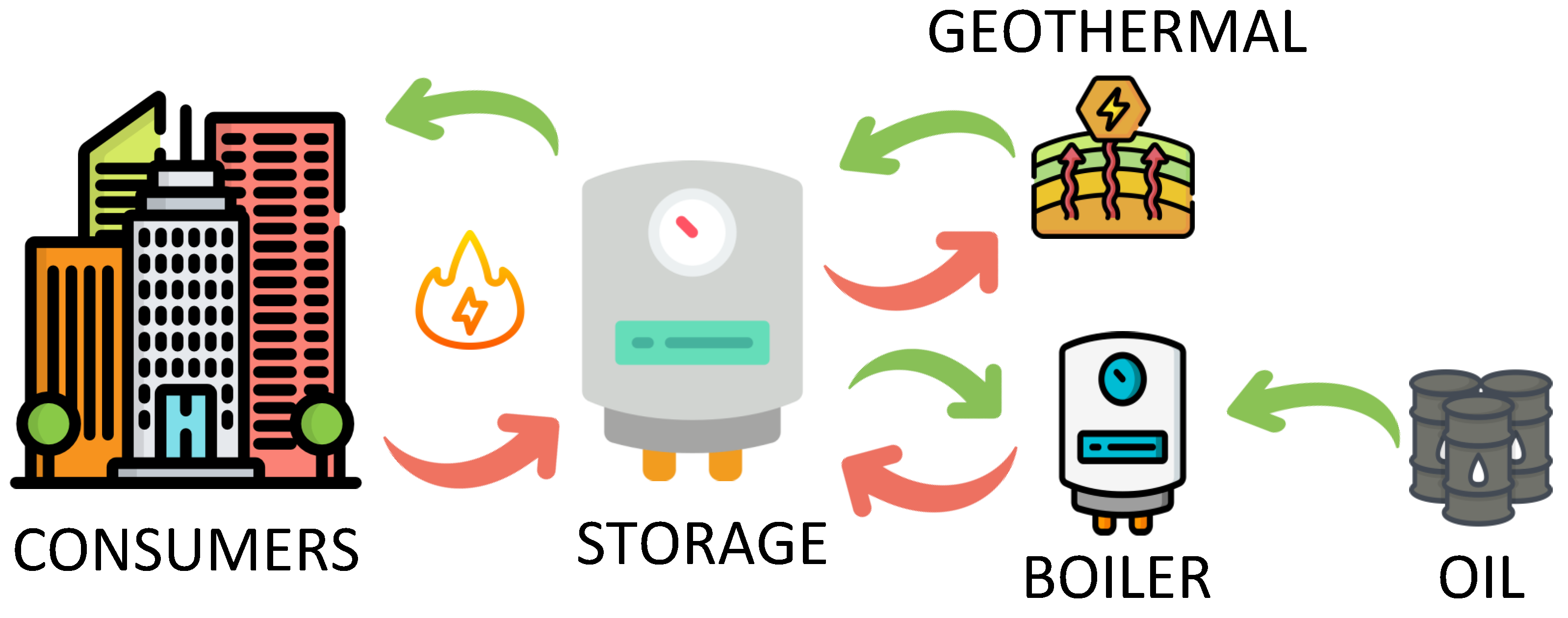
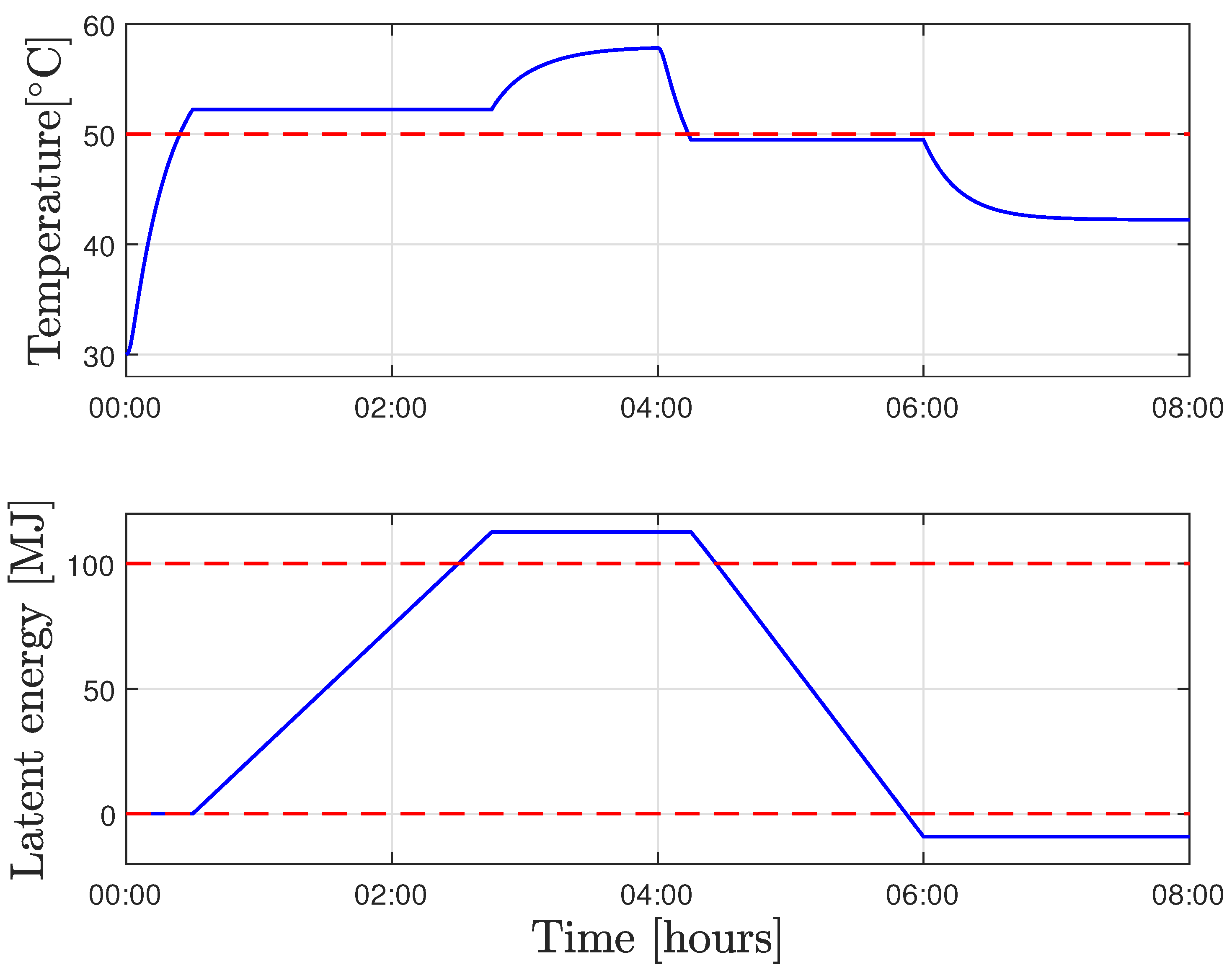
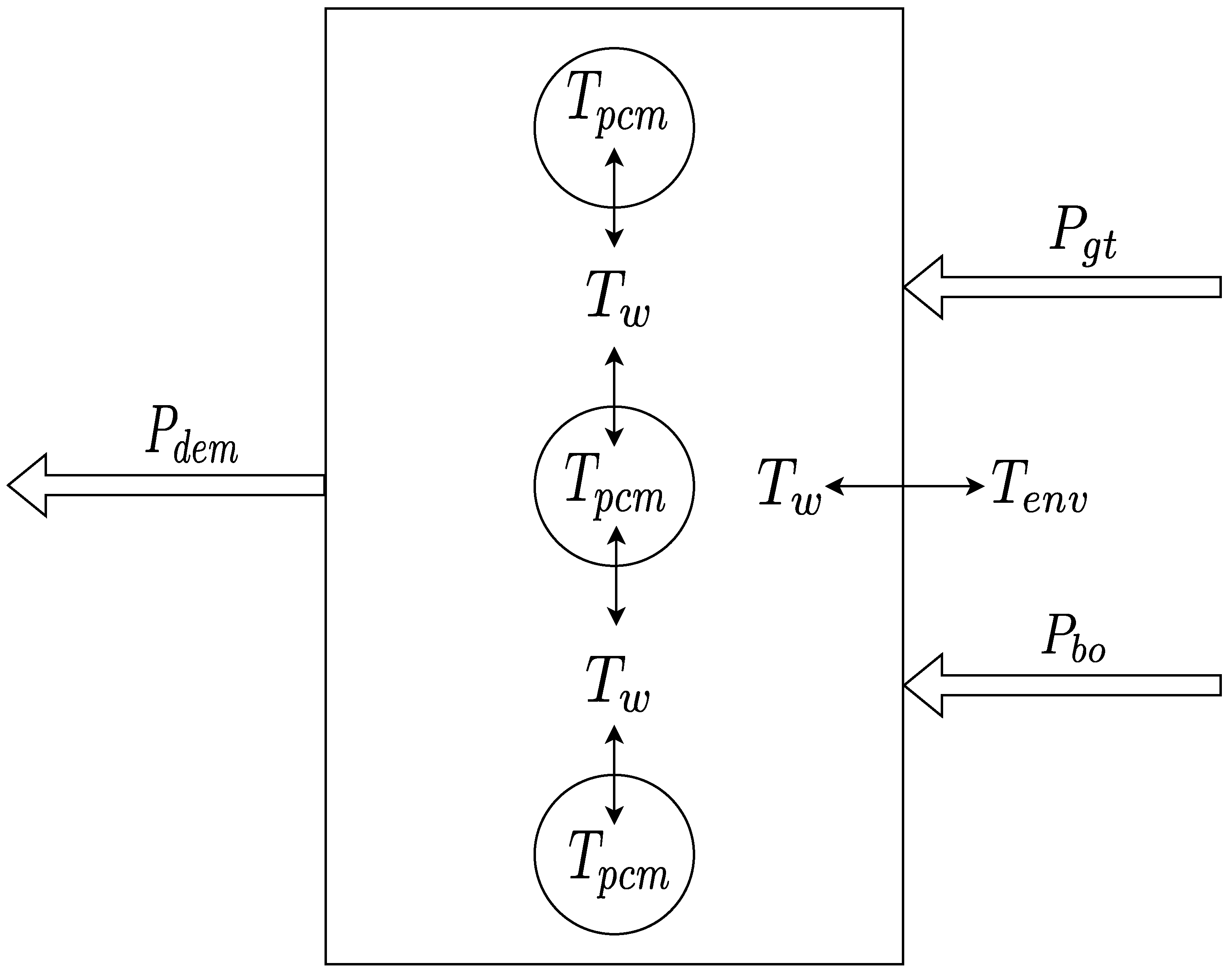
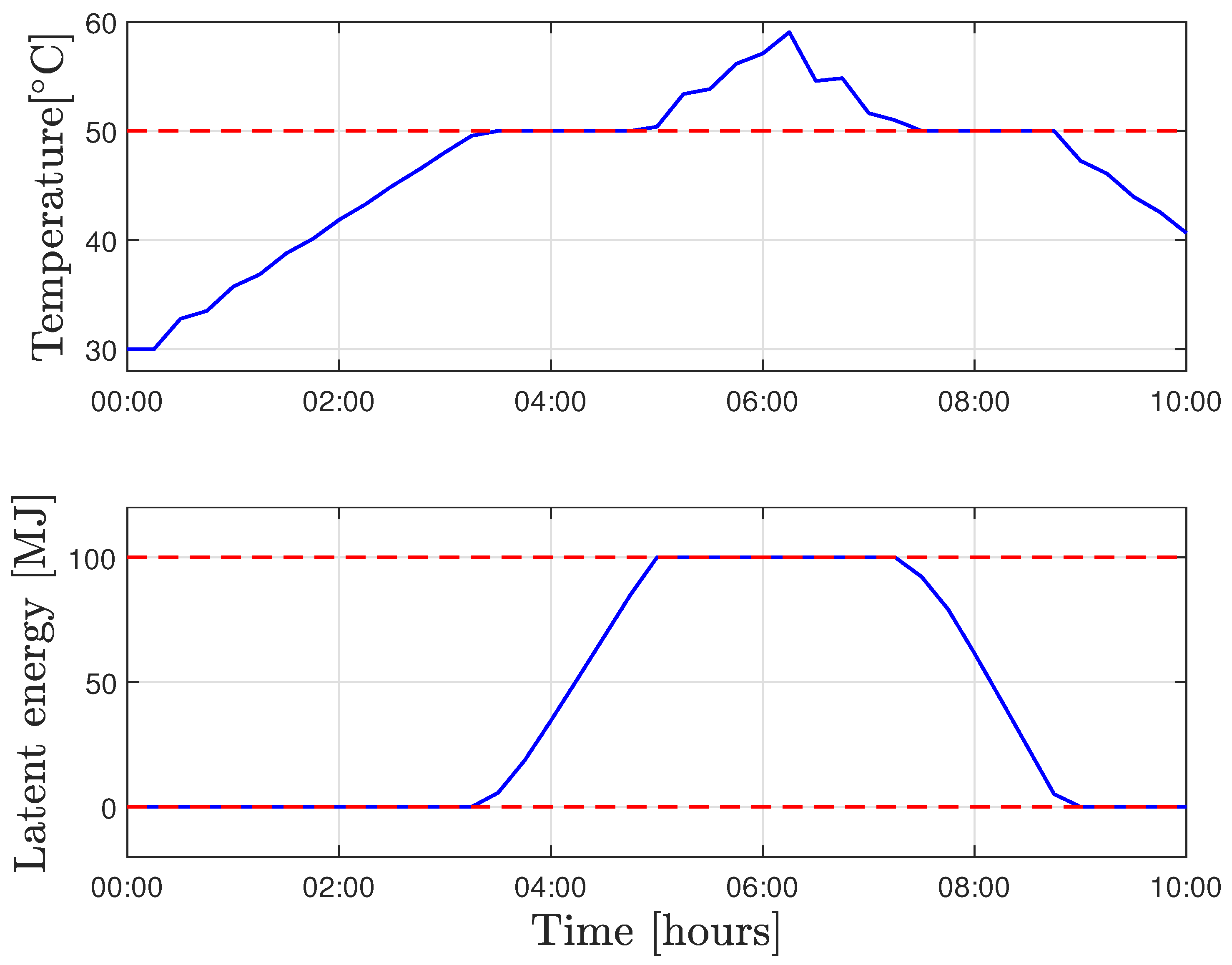
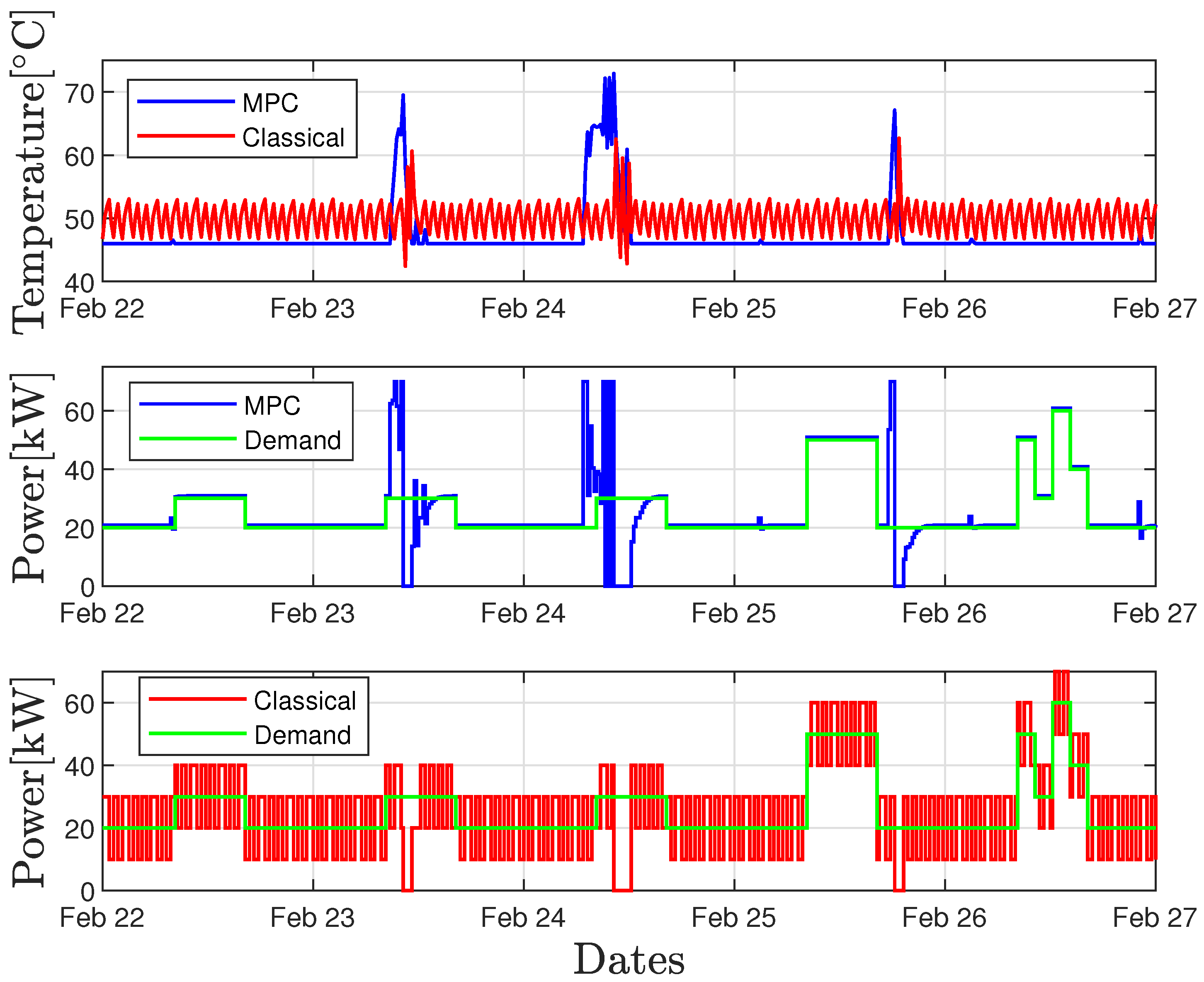
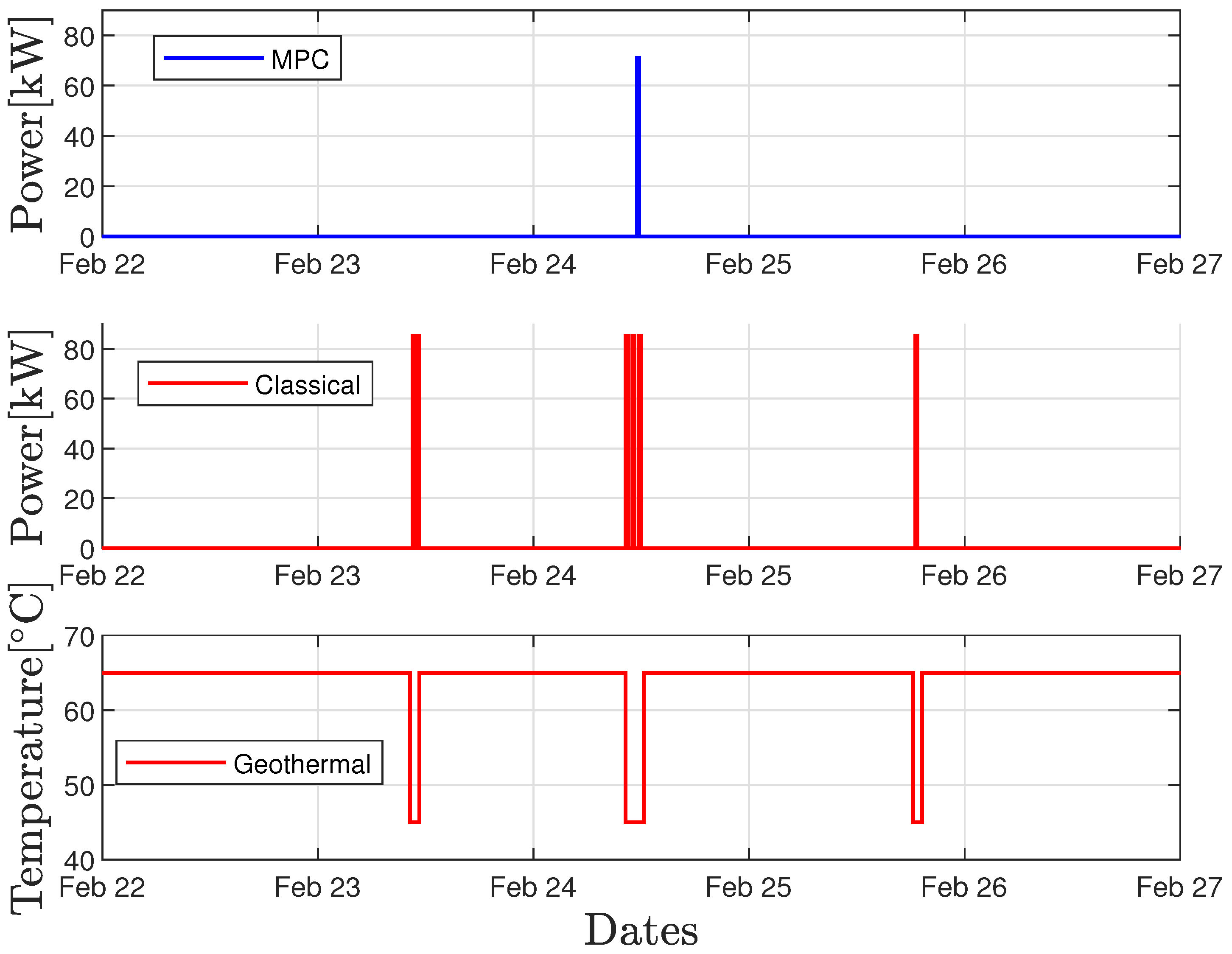
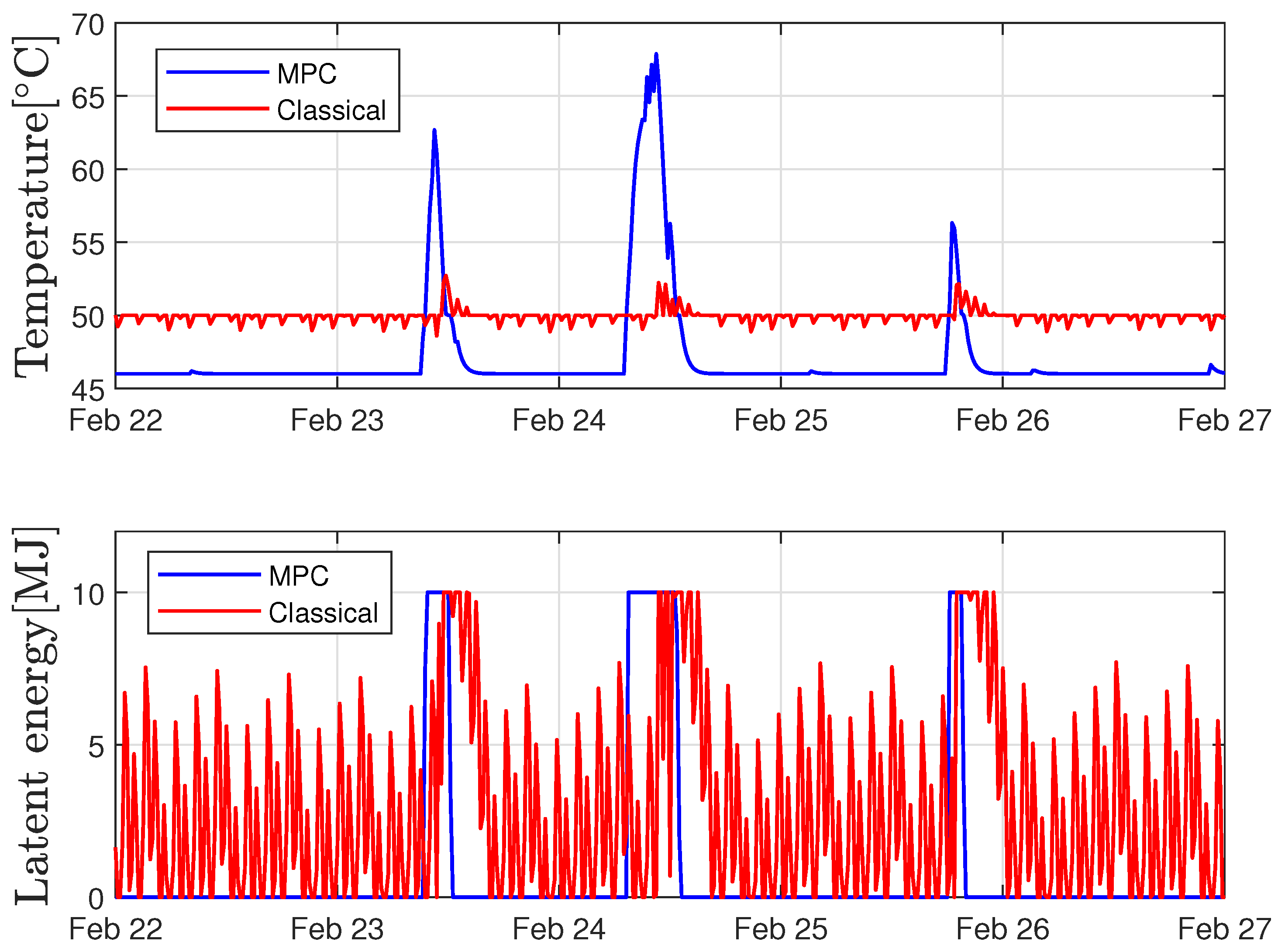
Disclaimer/Publisher’s Note: The statements, opinions and data contained in all publications are solely those of the individual author(s) and contributor(s) and not of MDPI and/or the editor(s). MDPI and/or the editor(s) disclaim responsibility for any injury to people or property resulting from any ideas, methods, instructions or products referred to in the content. |
© 2023 by the authors. Licensee MDPI, Basel, Switzerland. This article is an open access article distributed under the terms and conditions of the Creative Commons Attribution (CC BY) license (https://creativecommons.org/licenses/by/4.0/).
Share and Cite
Vrbanc, F.; Vašak, M.; Lešić, V. Simple and Accurate Model of Thermal Storage with Phase Change Material Tailored for Model Predictive Control. Energies 2023, 16, 6849. https://doi.org/10.3390/en16196849
Vrbanc F, Vašak M, Lešić V. Simple and Accurate Model of Thermal Storage with Phase Change Material Tailored for Model Predictive Control. Energies. 2023; 16(19):6849. https://doi.org/10.3390/en16196849
Chicago/Turabian StyleVrbanc, Filip, Mario Vašak, and Vinko Lešić. 2023. "Simple and Accurate Model of Thermal Storage with Phase Change Material Tailored for Model Predictive Control" Energies 16, no. 19: 6849. https://doi.org/10.3390/en16196849
APA StyleVrbanc, F., Vašak, M., & Lešić, V. (2023). Simple and Accurate Model of Thermal Storage with Phase Change Material Tailored for Model Predictive Control. Energies, 16(19), 6849. https://doi.org/10.3390/en16196849






